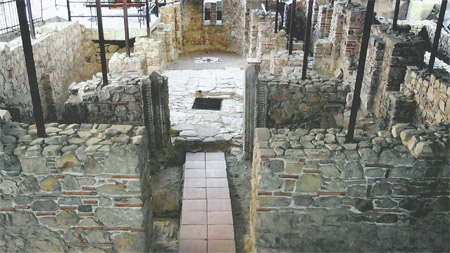Churches of the Fifteen Holy Martyrs of Tiberiopolis in Strumica
Kiril Trajkovski
The churches and graves of the Fifteen Holy Martyrs of Tiberiopolis are situated in the centre of the city of Strumica. Tiberiopolis is the name of the city one day’s walk north of Thessalonica, which was known in Antiquity as Astraion or Star City.
The memory of the people of Strumica and their devoutness and veneration of saintliness have persisted for 1,600 years; thus, in 1972, well-meaning amateurs discovered one of a number of Early Christian tombs of the Fifteen Holy Martyrs of Tiberiopolis. Who were these martyrs? During the Roman Emperor Julian the Apostate (Renegade) who ruled between 361 and 363, Christians suffered terribly or were persecuted. Thus, four men from the city of Nicaea in Asia Minor secretly escaped, reached Thessalonica and proceeded from there to Tiberiopolis (Strumica) to preach Christianity. Timothy, the first of them, became bishop, Comassius and Eusebius became monks, and Theodore was one of the blessed fathers of the Council of Nicaea who was also honoured with the rank of bishop. 
Soon, while they were preaching the holy Gospel to the virtue-loving population of Strumica and the region, they were joined by eleven men who became presbyters (Peter, John, Sergius, Theodore, Nicephorus), deacons (Basil, Thomas) and monks (Hierotheus, Daniel, Chariton). The fifteenth man whose name was Socrates was a soldier of great riches and glory, which he renounced and joined the holy fathers. The vigorous and productive Christian life of the fifteen fathers transformed the entire population of Strumica into followers of Christ and sowed the seeds of monastic life in Macedonia. However, the cruelty and ferociousness of the authorities were so great and inconceivable that they arrested them and sentenced them to death by quartering their bodies into pieces. They all perished on 28 November and parts of their bodies were desecrated, scattered around and left to the dogs, beasts and birds. It was only after their executioners left that the Christians gathered their remains with great honour and laid them to rest in Tiberiopolis.
The three-nave basilica with marble decorations and mosaic floors that has been discovered, as well as most of the vaulted early Christian tombs inside it decorated with crosses bear witness to this event that took place in the 4th century. In the 7th century, the city was devastated by the Avars, and the holy temples were levelled to the ground; thus, the tombs were buried under them, as it was recorded in the mediaeval manuscript of Teophylactus, Archbishop of Ohrid, in the 12th century. In the 9th century, the Bulgarian Prince Boris Michael built and restored many churches, especially in the regions of Strumica and Bregalnica. One of these monuments built in the spirit of the Macedonian renaissance was built above the tombs which cherished the memory of the Holy Martyrs of Tiberiopolis. In the central part of this church a crypt has been discovered in whose interior the fresco paintings of the figures of the fifteen martyrs can still be seen today.
In the 12th century the church was remodelled, while the three-part structure was preserved. The faithful added a parekklesion on its southeast side.
The veneration of the Fifteen Holy Martyrs, as well as the wish of the faithful to be near them, can be followed throughout the mediaeval period, when it became the burial site of the people of Strumica. The cult of the Fifteen Holy Martyrs of Tiberiopolis survives to this day, and to the Macedonian Christians, they epitomize ultimate saintliness.
References:
Teofilakt Ohridski, M√~eni~estvoto na 15-te tiveripolski m√~enici, IBI, Grcki izvori, IX, ~. II, 42-79, SofiÔ 1994.
D. Koco & P. Miqkovic, ”Rezultatite od arheolo{kite iskopuvawa vo 1973 god. vo crkvata “Sv. 15 tiveriopolski ma~enici” Strumica, Zb.AM, Skopje 1978, 93-104.
C.Grozdanov, Portreti na svetitelite od Makedonija od IX-XVII vek, Skopje 1983,127-138.
